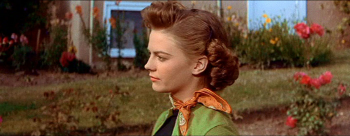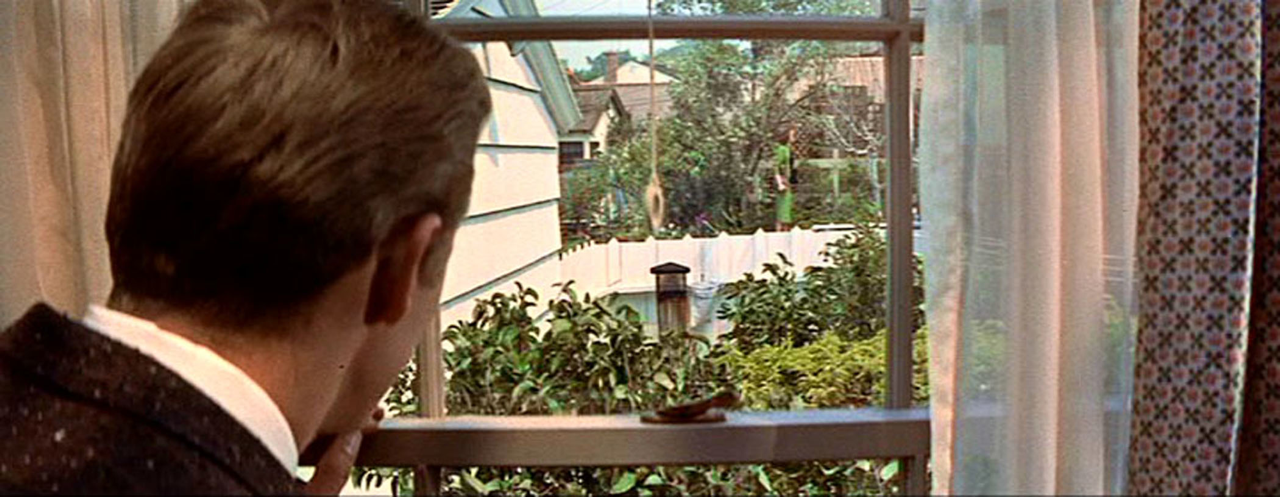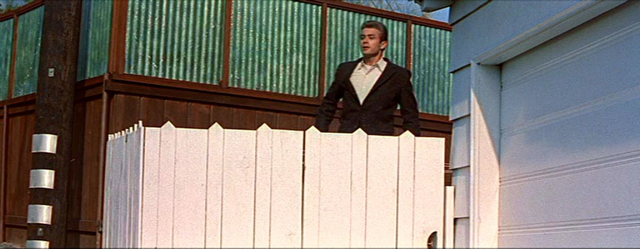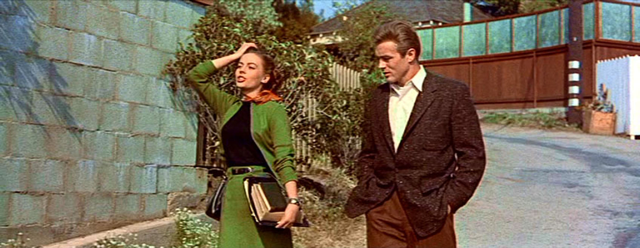“Who Lives?”: Notes on a Cinematic Moment
Murray Pomerance / Ryerson University

I would make the claim that the moment, not the shot or scene, is the unreducible element of cinema, both in terms of the way audiences interpret and experience what is onscreen and in terms of what filmmakers ultimately use their shots and scenes to accomplish dramatically or informationally. In The Horse Who Drank the Sky (36-61), I elaborate this thought theoretically by means of a number of “momentary” studies, some of which involve Nicholas Ray’s Rebel Without a Cause (1955). If the moment is as hard to define and describe as a quark, nevertheless in the true, unfolding experience of watching cinema, in our actual presence with the image, our sense of being struck depends on our relation to, and on the reverberations produced through our presence in, telltale moments. To explore one particularly fascinating such “event,” and possibly to learn in the process something about what the filmmaker’s mode of operation made possible in this medium, we might concentrate on something that happens early in Rebel, a film that has occasioned substantial comment already1.
The sweet-tempered and tempestuously anxious Jim Stark (James Dean) has discovered that living as his neighbor, in a genteel home on the other side of a curving backyard alley, is the neurotic and compulsive, but smashingly attractive girl he met in the police department’s juvenile division when the picture opened (Natalie Wood). Heading off in the morning for his first day in a new school, he has caught sight of her through the dining-room window, her lithe figure clad in an avocado-green suit utterly distracting him from his mother and grandmother spatting nervously about how he should be nourished.

He leaves without breakfasting, and catches Judy just at the moment she has paused beside a white budleia to furtively light up a smoke. Ray’s CinemaScope screen spreads this bush across almost half the screen, briefly turning Judy into a butterfly attracted by its scent.

The sun shines with promise. Nobody is around—one of those delicious morning instants in which a kid catches herself in the quick of being alive, snatches a breath away from parental observation and constraint, gets prepared for the show.
“Hi, wait a minute,” Jim calls, bouncing up over the top of his white picket fence (constructed for the shot) rather like a Jack-in-the-box.

She doesn’t want to wait, thinking, perhaps, only about the gang, who are about to materialize as escorts (and mock Jim, when he asks directions to “University and 10th”); her slight blush and still irrepressible smile indicate that she finds him attractive. But he will be embarrassing baggage once the gang is here.
Jim’s rhythm of thought and movement is flawless. He foregoes bringing out his car and trots after her, down the little slope that runs beside her house. Judy is used to being chased, knows how to turn her back on a boy without stepping on the gas. When he comes up beside her and offers that he’s seen her before, it is a defensive—some would say “cool”—tone of sarcasm she adopts: “Well! Stop the world!” She doesn’t have to be unfriendly, he suggests, and at this, in a beautifully casual gesture, she drops the cigarette (a prop for a quite different performance) out of her right hand and fluidly reaches up to run her fingers through her hair: in a single move, she thus both gathers and rejects formality of presentation. “Life is crushing in on me,” she says, blithely, again offering double meaning.

Her mock sententiousness indicates that she is quoting an unreliable source, and we may take this to be the adult generation that spends so much time these days decoding young people and trying to manipulate them through sympathetic understanding (a generation busy reading Frederick Wertheim on juvenile delinquency, and Ray’s target audience). Judy’s own parents are perfect monsters of guardianship: in their house, life is crushing in on her. Jim picks up her double clue doubly, and without losing a beat. “Life . . . can be . . . beautiful!” he intones, again mock quoting a well-meaning but totally out-of-touch adult perspective. She turns her head as she walks, giving him a peculiarly open regard. He is an object of appraisal, a spirit to meet, a focus for doubt and desire. Judy swivels her head to confront him offscreen-right. An orange silk scarf is knotted about her neck, to match her auburn hair. Behind her are roses. The picture is composed so that the edge of her profile as she looks right comes just to the middle (pictured at beginning of article). The right side of the screen is Jim’s absence.
Jim looks over her shoulder: “You live here, don’t you!”
She turns and walks left, her face souring. “Who lives?”
And this is the moment to which I wish to draw attention: “Who lives?” Ray composes a startling shot, that viewers are all too prone to absorbing without reflection or particular attention, a shot, indeed, that gives what we might think of as a “pungent” effect. “Pungent” from “pungere,” to pierce, prick, or sting. The word “punctum” is part of this verb, and gives us both “punctual” and “punctuate.” In Camera Lucida, Roland Barthes expanded the notion of the “punctum” in a photograph, and in Johnny Depp Starts Here, I borrowed from Barthes and addressed the idea of the cinematic punctum, the stinging point, if you will, at the heart of the cinematic moment. Even though more literary analysis than mine might suggest that Judy’s—somewhat celebrated—line of dialogue could be seen to take its meaning from the syntactical flow of this tiny conversation as it has been developing over the past few shots, its emplotting; or from the way it has been generally framed by the earlier encounter of these characters in this story or by the more general sociological observations that the filmmaker is offering as to his characters’ styles of life and the contingencies that appertain therein; still I think the most punctual reading depends on the organization of the shot as part of the construction of this moment in which Jim and Judy are both meeting and not meeting one another, discovering and still wanting to discover. As she says “Who lives?,” Judy is composed in the center of the expansive screen. Behind her, at the side of her parents’ house, and slowly shifting rightward as she moves left, are emplotments of a different kind, stunning roses in deep scarlet, sweet pink, off-white. The roses are dug into a well-defined bed at the edge of the road, bordered by a swath of drying grass and then, at the house wall, by taller, amber flowers. Two observations, merely to show how meticulous the filmmaker’s method is and to suggest lines of possibility for further inquiry:
First, Judy’s line, an epitome of ennui, alienation, even depression, but certainly a scathing social comment about the hollowness of teenage life so widely celebrated as wild and vivacious, is set against a flood of color, a simple and direct statement that there is life, and life here. Judy is herself a kind of flower, more alive than she knows herself to be (Ray’s affecting statement about youth, perhaps). And the flowers insist themselves on the viewer’s consciousness as pure instantiations of color and vivacity: insist themselves even as the conventional mode of reading figure/ground compositions with an eye that always defers to what it hears tends to obliterate them. Ray, of course, was contending against this mode. Further, the young people’s lives in this film are as fragile as flowers, easily picked off. We will discover this in many ways later in the film, just as we have been given hints already that a sensibility like Judy’s can so easily be snipped, left to moulder or dry up.
My other observation is more horticultural and sociological. The rose garden that belongs to Judy’s parents is, for all its brightness, also—as we see plainly in the composition—a more meager and less enthusiastic implantation than it might be. It’s for show only; to demonstrate to the neighbors (this sequence was filmed in the Baldwin Hills areas of Los Angeles–in order to gain authenticity, we are informed by Douglas L. Rathgeb in his dvd commentary) a requisite “fondness” for nature and financial capacity to acquire and display it. To affirm a proclivity toward bourgeois décor. But nobody in this house loves roses, or the girl who is now being compared with them through the agency of this metaphorical shot.
In this moment, we may say in summary, there is no separation between the action and the vision, between the performance and the composition. All of what is onscreen—gesture, expression, tonality, color, field, depth, extension, rhythm—contributes to our involvement, at once and in complex harmony.
Image Credits:
1. Judy’s Moment – Screen capture by author
2. Judy Sighting – Screen capture by author
3. Butterfly Judy – Screen capture by author
4. Jack-in-the-box – Screen capture by author
5. Judy’s casual gesture – Screen capture by author
Please feel free to comment.
- see, for example, Andrew 90-96; Eisenschitz 229-55; and Slocum [↩]
Thanks for sharing this article. I don’t really get into things like this but it was a great read for me. I was trying to find information about HCG homeopathic but stumbled upon this blog. I am glad I did.
is so funny
what is this? did you open a dictionary and start picking words at random? “characters’ styles of life and the contingencies that appertain therein”. Any thoughts you are trying to get across are lost in this maze useless diction; or vexing as you might say.
I do enjoy the juxtaposition of youth with flowers metaphor. The scene as you describe reminds me of the opening chapter of Oscar Wilde’s Portrait of Dorian Gray describing the garden they are viewing